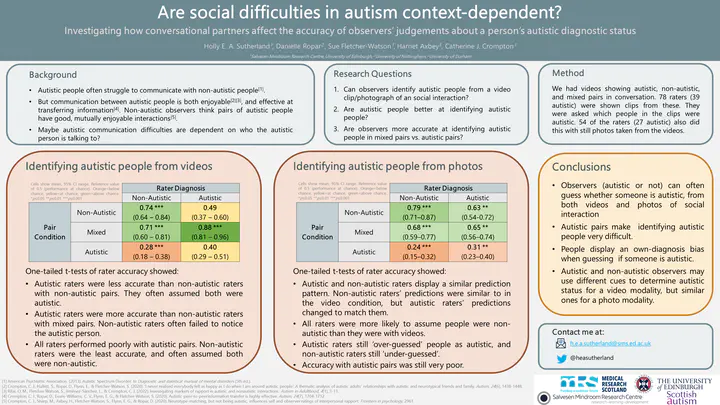Are social difficulties in autism context-dependent? Investigating how conversational partners affect the accuracy of observers’ judgements about a person’s autistic diagnostic status

Abstract
Introduction. Social and communication impairments are part of the diagnostic criteria for autism, but recent research has shown that social interaction and communication between autistic people are enjoyable for participants and efficient at transferring information. This suggests that autistic social/communicative “impairments” are dependent on the neurotype of the other member(s) of the interaction – as per Milton’s double empathy problem. This may make it more difficult for observers to accurately identify someone as autistic when they are interacting with another autistic person. Methods. We hypothesised that autistic people are easier to identify as autistic when interacting with non-autistic people. To test this, 78 raters (39 autistic; 39 non-autistic) watched clips from videos showing autistic dyads, non-autistic dyads, and mixed dyads conversing, and were asked to identify whether each member of the dyad was autistic. A subset of 54 participants repeated this procedure with photographs of dyads in conversation. Results. Raters correctly identified the neurotype of dyad members at a rate better than chance for videos (0.58, p<0.001) and photographs (0.55, p<0.001). However, accurate identification for autistic dyads was significantly below chance for both videos (0.34, p<0.001) and photographs (0.27, p<0.001). For videos, ratings of mixed dyads had the highest accuracy (non-autistic raters 0.71 p<0.001; autistic raters 0.88 p<0.001); for photographs, non-autistic dyads had the highest accuracy rate overall. For videos, both autistic and non-autistic raters showed an own-neurotype accuracy effect across all dyad types (autistic raters outperformed non-autistic raters for autistic and mixed pairs; the opposite for non-autistic pairs). Discussion. This research provides tentative further support for the double empathy problem – a non-stigmatising and neurodiversity-oriented understanding of autistic social communication. However, further research with a larger sample size is required to support the robustness of the findings reported here. Better understanding of whether and how autistic people recognise one another could lead to improvements in how we identify/diagnose autism, by providing insight into what autistic people intuitively understand as being ‘autistic behaviour’.